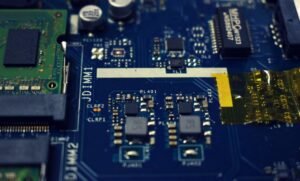How Artificial Intelligence Works
Artificial Intelligence (AI) is a branch of computer science that focuses on the development of computer systems capable of performing tasks that normally require human intelligence.
Key Takeaways:
- AI involves the development of computer systems that can perform tasks requiring human intelligence.
- Machine learning, natural language processing, and computer vision are important components of AI.
- The goal of AI is to create systems that can learn, reason, and make decisions.
- AI has applications in various industries including healthcare, finance, and transportation.
**AI relies on several key technologies, including machine learning, natural language processing (NLP), and computer vision.** Machine learning enables computers to learn from experience and improve their performance on specific tasks without explicit programming. *For example, an AI-powered spam filter can learn to identify and block spam emails based on patterns and characteristics it detects.* NLP allows computers to understand and interpret human language, enabling applications like virtual assistants and language translation. Computer vision enables computers to analyze and interpret visual information, enabling applications such as facial recognition and object detection.
How AI Works:
AI systems typically go through the following steps:
- Data Collection: Collect relevant data from various sources, which forms the basis for training the AI system.
- Data Preprocessing: Clean and prepare the collected data, ensuring it is in a suitable format for analysis.
- Model Training: Use machine learning algorithms to train the AI model on the prepared data.
- Model Evaluation: Assess the performance of the trained model using evaluation metrics and validation techniques.
- Model Deployment: Deploy the trained model for real-world applications and continuously monitor its performance.
*AI systems can analyze large amounts of data quickly and accurately, providing insights and making predictions in various domains, such as healthcare and finance.* Additionally, AI algorithms can adapt to new data, enabling continuous learning and improving accuracy over time.
Applications of AI:
The capabilities of AI have led to its adoption in various industries, some examples include:
- Healthcare – AI is used for medical diagnosis, drug discovery, and personalized treatment plans.
- Finance – AI is employed for fraud detection, risk assessment, and algorithmic trading.
- Transportation – AI is used for autonomous vehicles, traffic management, and predictive maintenance.
Data Points:
| Industry | AI Applications |
|---|---|
| Healthcare | Medical Diagnosis, Drug Discovery, Personalized Treatment |
| Finance | Fraud Detection, Risk Assessment, Algorithmic Trading |
| Transportation | Autonomous Vehicles, Traffic Management, Predictive Maintenance |
**In conclusion,** AI is revolutionizing various industries by enabling machines to perform complex tasks that were previously limited to human capabilities. With ongoing advancements and further integration, AI will continue to have a significant impact on society, improving efficiency and transforming the way we live and work.

Common Misconceptions
Misconception 1: AI can think and feel like humans
One common misconception people have about AI is that it possesses human-like cognitive abilities and emotions. However, artificial intelligence is primarily based on algorithms that enable it to process data and make decisions, but it does not have consciousness or emotions.
- AI can only imitate human behaviors, not actually experience them.
- Real emotions depend on subjective experiences, which AI lacks.
- AI’s decision-making is based on logical rules, not personal biases or gut feelings.
Misconception 2: AI will replace humans in every job
Another misconception is that AI will replace humans across all industries, leading to mass unemployment. While AI can automate certain tasks and improve efficiency, it is not capable of completely replacing the complex, creative, and interpersonal skills that humans possess.
- AI is more likely to complement human work rather than replace it entirely.
- Jobs that involve critical thinking, empathy, and creativity are less likely to be automated.
- Certain industries may require human judgment and instincts that AI cannot replicate.
Misconception 3: AI is infallible and has no biases
There is a misconception that AI-based systems are completely objective, free from biases and errors. However, AI systems are developed and trained by humans, and they can inherit the biases present in the data and algorithms used to train them.
- AI systems can perpetuate and amplify existing biases in society.
- Data used to train AI systems may not be representative or diverse enough to avoid biases.
- Regular audits and ethical considerations are necessary to mitigate biases in AI systems.
Misconception 4: AI is always a threat to humanity
Thanks to movies and popular media, many people view AI as a potential threat to humanity, leading to scenarios of robots taking over the world. However, this is a misconception fueled by sensationalism rather than reality.
- AI is a tool created by humans and its intentions depend on how it is programmed and used.
- AI is designed to enhance human capabilities, not to replace or harm us.
- Proper regulations and ethical guidelines can ensure responsible and safe use of AI.
Misconception 5: AI can provide unlimited knowledge and accuracy
Some people expect AI to have unlimited knowledge, always providing accurate and flawless answers to any question. However, AI systems are only as good as the data they have been trained on and the algorithms they use.
- AI systems can make mistakes, especially in complex and ambiguous situations.
- The accuracy of AI systems relies on the quality and diversity of the data used for training.
- AI systems may need continuous updates and improvements to keep up with evolving information.

What is Artificial Intelligence?
Artificial Intelligence (AI) refers to the simulation of human intelligence in machines that are programmed to think and learn like humans. AI has become an integral part of our lives, impacting various industries such as healthcare, finance, and transportation. To help you understand how AI works, here are 10 interesting tables showcasing different aspects of this groundbreaking technology:
1. AI Applications in Healthcare
AI is revolutionizing healthcare by enhancing diagnostics, drug discovery, and patient care. The table below illustrates the various applications of AI in healthcare:
| AI Applications | Description |
|---|---|
| Medical Imaging | AI algorithms can analyze medical images to detect diseases like cancer with high accuracy. |
| Virtual Nursing Assistants | AI-powered chatbots can provide personalized healthcare advice and guidance. |
| Genomics | AI algorithms can analyze vast amounts of genetic data to identify disease risk factors. |
2. Rise of AI Startups
The AI industry is experiencing exponential growth with numerous startups emerging worldwide. This table showcases the top countries with the highest number of AI startups:
| Country | Number of AI Startups |
|---|---|
| United States | 1,487 |
| China | 966 |
| United Kingdom | 380 |
3. AI in Autonomous Vehicles
Autonomous vehicles are reshaping the transportation industry by incorporating AI for navigation and decision-making. The table highlights the major components of AI in autonomous vehicles:
| Component | Description |
|---|---|
| Computer Vision | AI systems analyze video feeds to detect and understand objects on the road. |
| Natural Language Processing | AI enables communication between passengers and the vehicle through voice commands. |
| Machine Learning Algorithms | AI algorithms learn from vast amounts of data to improve the vehicle’s driving capabilities. |
4. AI Job Market Trends
The demand for AI professionals is skyrocketing, creating a competitive job market. The table below presents the projected job growth for AI-related occupations:
| Occupation | Projected Job Growth |
|---|---|
| Data Scientist | 31% by 2029 |
| Machine Learning Engineer | 21% by 2029 |
| AI Research Scientist | 16% by 2029 |
5. AI in Finance
The financial industry is leveraging AI to improve fraud detection, customer service, and algorithmic trading. The table highlights the benefits of AI in finance:
| Benefits of AI in Finance |
|---|
| Improved Risk Assessment |
| Enhanced Fraud Detection |
| Efficient Algorithmic Trading |
6. AI in Entertainment
AI is transforming the entertainment industry by personalizing content recommendations and creating realistic virtual characters. The table below showcases the AI-driven advancements in entertainment:
| Advancements |
|---|
| Personalized Content Recommendations |
| Virtual Reality (VR) Experiences |
| AI-generated Music and Art |
7. Ethics and AI
The ethical implications of AI are a crucial aspect to consider. The table presents the key ethical concerns surrounding AI development and usage:
| Ethical Concerns |
|---|
| Privacy and Data Security |
| Algorithmic Bias |
| Automation and Job Displacement |
8. Chatbots and Virtual Assistants
Chatbots and virtual assistants are becoming increasingly popular, revolutionizing customer service and support. The table below highlights the advantages of using AI-powered chatbots:
| Advantages |
|---|
| 24/7 Availability |
| Reduced Response Time |
| Cost Savings |
9. AI and Cybersecurity
AI plays a vital role in enhancing cybersecurity measures to detect and prevent malicious activities. The table explores the application of AI in cybersecurity:
| Applications | Description |
|---|---|
| Behavioral Analysis | AI algorithms analyze user behavior to identify potential threats or anomalies. |
| Automated Threat Response | AI systems can respond to cyber threats in real-time, reducing response time. |
| Network Traffic Monitoring | AI monitors network traffic patterns to detect suspicious activities. |
10. Future Impact of AI
The future impact of AI is vast, with advancements expected in various fields. The table below highlights the potential benefits of AI in the near future:
| Potential Benefits |
|---|
| Improved Efficiency and Productivity |
| Enhanced Healthcare and Disease Diagnosis |
| Smarter Cities with AI-driven Infrastructure |
Artificial Intelligence has undoubtedly transformed the way we live and work, offering immense potential to tackle complex challenges. From healthcare to finance, AI is reshaping industries and revolutionizing human capabilities. As technology continues to evolve, the future of AI holds the promise of a more efficient and advanced world.
FAQs: How Artificial Intelligence Works
How does artificial intelligence work?
Artificial intelligence (AI) works by simulating human intelligence in machines. It involves the development of computer systems capable of performing tasks that typically require human intelligence, such as speech recognition, decision making, learning, problem-solving, and language translation.
What are the key components of artificial intelligence?
The key components of artificial intelligence include machine learning, natural language processing, computer vision, and expert systems. Machine learning enables AI systems to learn and improve from data, while natural language processing allows machines to understand and process human language. Computer vision enables AI systems to interpret and understand visual information, and expert systems mimic human expertise to solve complex problems.
What is machine learning?
Machine learning is a subset of AI that focuses on developing algorithms that allow computers to learn and improve from experience without being explicitly programmed. It involves training a model on a large dataset to recognize patterns and make predictions or decisions based on new, unseen data.
How does natural language processing (NLP) work?
Natural language processing is the field of AI that focuses on enabling machines to understand and interpret human language. NLP algorithms analyze and process text or speech data, allowing machines to extract meaning, respond to queries, perform sentiment analysis, or even generate human-like responses.
What is computer vision?
Computer vision is the aspect of AI that deals with enabling machines to interpret and understand visual information. Computer vision algorithms process images or videos to recognize objects, detect patterns, track movements, or even analyze facial expressions.
What are expert systems?
Expert systems are AI systems designed to replicate human expertise in a specific domain. They use knowledge bases and rules to reason and make decisions or provide recommendations. Expert systems are commonly used in areas such as medicine, finance, or engineering to assist professionals in complex problem-solving tasks.
How does artificial intelligence learn and improve over time?
Artificial intelligence systems improve over time through a process called training. During training, AI models are exposed to large amounts of data and feedback, allowing them to learn and adjust their algorithms to improve performance. This iterative process helps AI systems continuously refine their abilities and make better predictions or decisions.
What are the ethical considerations of artificial intelligence?
As AI becomes more advanced and integrated into various aspects of society, ethical considerations arise. Issues such as privacy, bias in data or algorithms, job displacement, and the potential for autonomous weapons raise important ethical questions. Ensuring that AI systems are designed and used responsibly is crucial to mitigate these concerns.
What are some real-life applications of artificial intelligence?
Artificial intelligence has numerous applications across various industries. Some examples include virtual assistants like Siri or Alexa, autonomous vehicles, fraud detection in finance, personalized recommendations in e-commerce, medical diagnostics, and even game playing systems like AlphaGo.
What is the future of artificial intelligence?
The future of artificial intelligence is promising and full of possibilities. AI is expected to continue advancing, leading to advancements in healthcare, transportation, automation, and many other fields. With ongoing research and development, AI may bring about profound changes and benefits to society.




